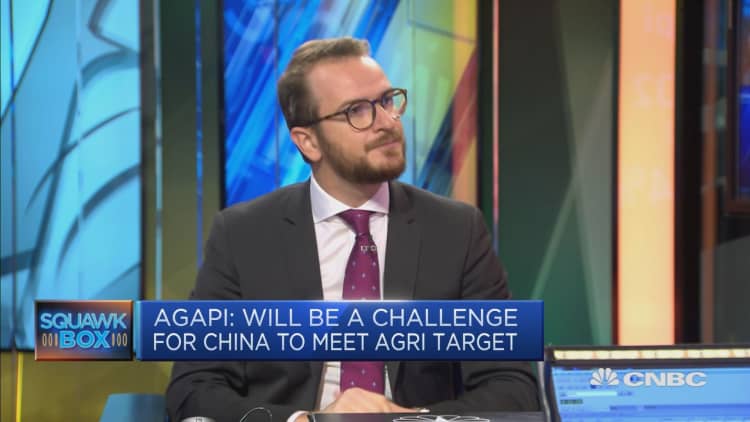A leading commodities expert at Goldman Sachs has raised doubts over China buying at least $40 billion worth of U.S. farming goods to satisfy terms of the "phase one" trade deal.
The U.S. and China plan to sign the first draft of the trade pact on January 15 which will see tariffs eased and changes introduced to rules surrounding intellectual property and technology. Washington is also demanding that China buys between $40 billion and $50 billion worth of agricultural goods from the U.S. each year.
Speaking to CNBC's "Street Signs" on Friday, Goldman's Global Head of Commodities Research Jeff Currie said U.S. live stock and agricultural prices couldn't yet factor in a coming boost to demand.
"There is still a lot of uncertainty about how you would achieve $40 (billion) or potentially even $50 billion of agricultural purchases," Currie said, before adding, "A lot of the people I talk to are really skeptical that you can really achieve that number."
Annual U.S. farm exports to China typically exceeded $20 billion between 2010 and 2018, before falling sharply to around $13 billion over the last two years as trade war duties impacted sales of soy beans and pork.
U.S. Trade Representative Robert Lighthizer told reporters in December that China has pledged to buy a total of $40 billion in agricultural products, although President Donald Trump is calling for $50 billion.
The $40 billion figure represents a $24 billion a year baseline based on 2017 figures, plus an additional $16 billion for at least two years.

To suddenly reach an annual $40 billion figure as soon as this year, Currie said there would need to be a big increase in soybean exports — a tricky prospect given a swine fever outbreak that has reduced the number of pigs in China that are typically fattened up on soy beans.
Currie said there would need to be deep analysis on what else China needed.
"You put it all together and you say 'OK, what is China short? What is the U.S. long?' …. The two markets where you could see the biggest increases are corn, as well as pork."
Currie said while Goldman Sachs had identified soy beans, pork and corn as the likely big winners from the "phase one" trade deal, it would be a question of waiting to see if the physical demand existed.
"When you actually see boats loaded and what's on those boats then the question is going to be which commodity is the one that can perform here," said Currie.
Now watch: U.S.- China trade deal key for agriculture



